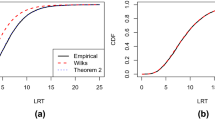Abstract
Estimators which are efficient in the sense of having minimum asymptotic variance are obtained for the structural parameters of Lazarsfeld's latent class model of latent structure analysis. Sufficient conditions for the local identification of the structural parameters are also presented.
Similar content being viewed by others
References
Anderson, T. W. On estimation of parameters in latent structure analysis.Psychometrika, 1954,19, 1–10.
Coombs, C. H. A theory of psychological scaling. Eng. Res. Bull. No. 34, University of Michigan, 1952.
Fisher, R. A. The conditions under which chi square measures the discrepancy between observation and hypothesis.J. R. stat. Soc., 1924,87, 442–450.
Gulliksen, H. Theory of mental tests. New York; Wiley, 1950.
Hurwicz, L. Generalization of the concept of identification. Statistical inference in dynamic economic models. Cowles Commission Monograph 10. 1950, 245–257.
Koopmans, T. C. and Reiersøl, O. The identification of structural characteristics.Ann. math. Stat., 1950,21, 165–181.
Lord, F. A theory of test scores. Psychometric Monograph, No. 7, 1952.
Neyman, J. Contribution to the theory of the x2-test. Proceedings of the Berkeley Symposium on Mathematical Statistics and Probability. Berkeley: University California Press, 1949.
Neyman, J. and Scott, E. L. Consistent estimates based on partially consistent observations.Econometrica, 1948,16, 1–32.
Rao, C. R. Advanced statistical methods in biometric research. New York: Wiley, 1952.
Reiersøl, O. On the identifiability of parameters in Thurstone's multiple-factor analysis.Psychometrika, 1950,15, 121–149.
Schumacher, C. F., Maxson, G. R., and Martinek, H. Tests for creative ability in machine design. Annual report, 1953. Project ONR 458. Armed Services Technical Information Agency 21 284.
Stevens, S. S. Handbook of experimental psychology. New York: Wiley, 1951.
Stouffer, S. A., Lazarsfeld, P. F., et al. Measurement and prediction. Princeton: Princeton Univ. Press, 1950.
Author information
Authors and Affiliations
Additional information
The writer wishes to acknowledge with appreciation the helpful advice of Professors Leonid Hurwicz and Jacob Bearman of the University of Minnesota. Dr. John Gurland of Iowa State College assisted the author in clarifying certain points in this article.
Rights and permissions
About this article
Cite this article
McHugh, R.B. Efficient estimation and local identification in latent class analysis. Psychometrika 21, 331–347 (1956). https://doi.org/10.1007/BF02296300
Received:
Revised:
Issue Date:
DOI: https://doi.org/10.1007/BF02296300




